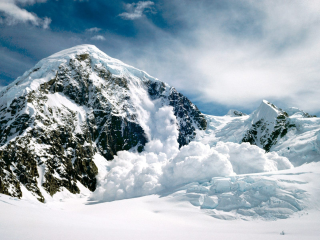


Anyone visiting during the winter will be drawn to spend time in its wonderful backcountry whether on skis / snowboards, snowshoes or a snowmobile. While the experience can be one of the highlights of your visit, once you set foot outside conuolled areas (essentially Alpine Resort), you expose yourself to substantial avalanche risk. Legendary deep powder and steep mountains can be fatal if not approached with respect.
While Search and Rescue will help those who get lost or into difficulty in the winter months, it is better for all concerned if we are not called out at all. As such, we set out below a summary list of what steps to take to ensure your winter is fun and incident-free.
There's been a big dump and you want to head out for some fresh turns. But is it safe? This is not something that can readily be assessed without years of experience. So turn to those that have that experience - read the backcountry bulletin posted daily at Alpine Resort. It outlines basic observations from the area and can be supplemented by asking any of the Ski Patrol Staff about what has been happening with the snow. Visit the Canadian Avalanche Association website at www.avalanche.ca where you will find the best resource for regional backcountry conditions spanning all of western Canada's mountain ranges.
This is also a valuable site for information on avalanche safety courses, current issues and special backcountry advisory bulletins. The avalanche bulletin along with local area advisories, a careful eye to the weather, education and likewise equipped partners should set you up for loads of backcountry turns and make sure that a drink by the fire finishes your day.
A relatively new service is the "Avaluator" - a detailed database which allows you to enter your intended day of travel and specific destination and will then give you an avalanche advisory recommendation. This is a tool that has had lots of energy put into it; try it out this winter.
Keep in mind that any forecasts or predictions are general. Even on a low risk day that particular perfect white slope sitting in the sun begging you to put in a turn may be off-the-scale risk-wise.
If you are heading into the backcountry then you need to be equipped in case your pre-trip information turns out to have been overly optimistic. Keep in mind that avalanche safety gear is designed to work after the fact, after an avalanche has slid and the buried victims must be found. The only thing that will help prevent accidents is informing yourself to decide whether you should be heading out, and once out, your own skill at assessing both terrain and conditions.
The mandatory items that a backcountry skier or boarder must carry are a transceiver, probe, and shovel.
Ensure that you and all members of your group know how to use them before you set out. After 15 minutes under snow a burial victim's chances of survival diminish rapidly so every second counts. Because of this narrow window of time, it means that self-rescue is your best chance at survival.
If calls need to be made to Search and Rescue, the response time will almost inevitably take us outside of that first 15 minutes. If a member of your group does not have the equipment, they should not be heading out. Keep in mind that the guy without the transceiver might be the one looking for you. Also get into the habit of doing a quick equipment test before setting out. Just because your transceiver was working last week does not mean that it will be today. Having the right equipment and being in a group that knows how to use it can mean the difference between rescue or body recovery.
Start the season with a refresher on how to use your avalanche safety gear, even if you have plenty of experience. Search and Rescue will be hosting a (free) transceiver training session as well as a mock avalanche rescue. Look out for posters around town in December and come along.
You'll get a chance to meet plenty of Search and Rescue members, ski patrollers and various snow professionals. Otherwise consider taking the Avalanche Skills Training (AST) course which is run in town.
If you plan to head out on a snowmobile, check in with the Snowmobile Association for advice on terrain and safety in the area.
When heading out, please ensure that someone responsible is informed of where you are heading, and when you are due back. While a major effort can be mounted to look for missing recreationalists, the area is vast and we need your help to ensure we are looking in the right place. Make sure you let them know you are back before you head out to the bar.
Try to stay to areas that you know, take someone who does know the area, or at least ask people who do. Plenty of people get lost in the backcountry, the terrain is complicated, it gets dark fast and everywhere looks the same in the snow when you are lost. Above all, have fun, play safe and we'll see you out there.
Search and Rescue is an organization of voluntary members sponsored by the provincial government to offer assistance to those who find themselves in difficulty in the backcountry.
In the winter the focus moves to assisting snowmobilers, skiers and other winter recreationalists who get into trouble in the vast backcountry areas. The organization has considerable resources at its disposal including avalanche technicians, first aid equipment, snowmobiles, ATVs and helicopters.
As a voluntary organization, we rely solely on grants and donations to operate.